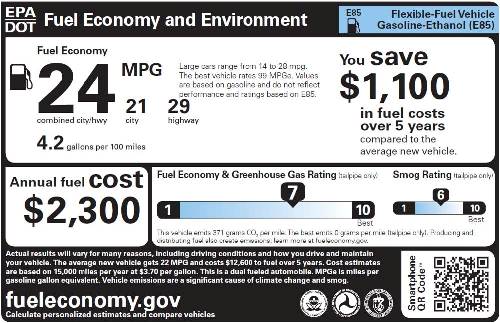
Ed. Note: Cross posted from the Department of Transportation's Fast Lane blog. Secretary LaHood and EPA Administrator Lisa Jackson will hold a press conference today at 10:30 a.m. EDT on this to discuss the new fuel economy labels. You can watch the press conference live here.
This Administration has taken unprecedented steps to protect consumers at the gas pump. In March, the President announced a plan to reduce our oil imports by a third by 2025--leveraging domestic resources while reducing the oil we consume. Since the beginning, this Administration has been making investments and taking smart steps that are already helping us move towards this important goal. You can see it in our investment in alternative fuels and our support of electric vehicles--creating jobs while decreasing costs for consumers.
Most importantly, you can see it in the historic, national fuel economy standards for passenger cars and trucks achieved last year under President Obama’s leadership.
Today, I'm excited to join Environmental Protection Agency Administrator Lisa Jackson in introducing new fuel economy labels that will empower car buyers with better information about what they will spend or save on fuel costs when looking to purchase a new vehicle. This is one part of President Obama's plan to provide Americans with relief from high gas prices and break our dependence on foreign oil.
These labels offer consumers more information in a more usable format. When shopping for a new vehicle, you'll be able to see your expected savings over a five-year period, a fuel economy comparison to other vehicles in the same class, and easy-to-understand guidance about each car or truck’s environmental impact. The bottom line is that these labels will help people make informed decisions when they're buying a car, so that they can save money at the gas pump.
The new labels also feature a QR code that allows car buyers to comparison shop on the go. Shoppers can scan the QR code with their smartphones to store that vehicle's information, compare it to other vehicles, and access www.fueleconomy.gov for even more information.
Because of President Obama's efforts and automakers' innovations, Americans today have many more options for fuel-efficient vehicles than ever before. And the new labels will help us make sense of those options and take advantage of the new, more energy efficient fleet to save money and reduce tailpipe emissions.
Perhaps the most terrific thing about these labels is that--despite their sophistication--they are easy to understand. We're talking about a new generation of labels for a new generation of cars.
We know that transportation is one of the biggest costs in any family's budget. When we provide more useful information about how a family's budget will be affected by a new car or truck purchase, we're empowering Americans to make better decisions and save more money.
And with the labels we're introducing today, shoppers will be armed with the most powerful informational tools yet to make the best decision for their families, their wallets, and the air we breathe.



